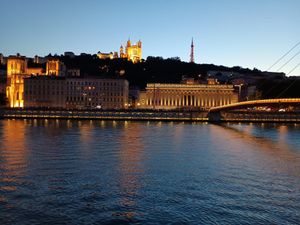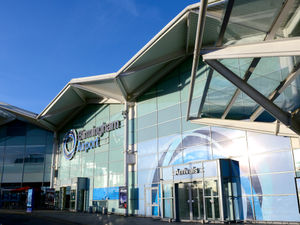Travel review: Booze, blues and friends in Chicago
“Hear blues - drink booze - talk loud - you’re among friends.”
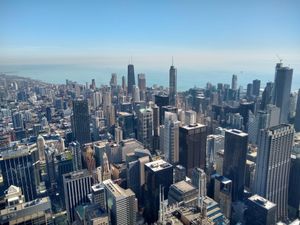
At Kingston Mines blues club they know how to show you a good time. And it’s not just great mottos on offer - the booze and blues are supplied seven nights a week, just follow the instructions and fun is guaranteed.
Indeed, taken more broadly the motto could just as accurately apply to Chicago as a whole, with the four key ingredients available in abundance across the city.
For “hear blues”, think music, art and theatre. For “drink booze”, think craft beer, craftier cocktails and food far more delicate than you might expect in a town known for deep dish pizza. For “talk loud” think loud ideas, loud sculptures and Chicagoans proudly enthusing about their city. As for being among friends - you can take that one literally. It’s a friendly old place, Chicago.
Giant beans and giant buildings
Let’s start with talking loud.
When you meet one of Chicago’s many proud ambassadors, there’s one word you’ll hear repeatedly: architecture. And, being British, you might at first be snobbish in a city where the oldest building is centuries younger than your local pub. But as you squint up towards the shining skyscrapers, stare down at the street-level sculptures and gaze across the vast Lake Michigan, you realise that Chicagoans have every right to be loud and proud.
Here tall and new has not translated into bland and generic.
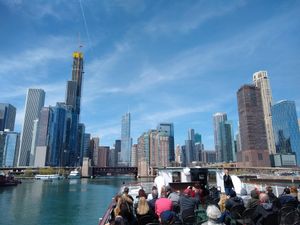
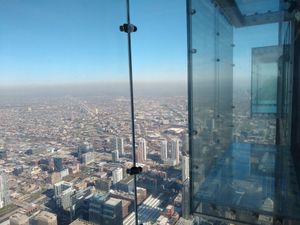
At Marina City, the ‘corn-cob’ 1960s high-rise, apartments spiral into the sky above an open-air car park where valet parking is compulsory to stop the cars rolling into the water. At grafity-defying 150 North Riverside, 54 storeys grow terrifyingly taller and wider out of just 39ft of floor space. And at the city’s most famous piece of public art, tourists take skyline selfies from the reflection of a giant steel bean. Innovation is everywhere.
And while the clean, wide (and yes, often windy) streets make walking a joy and the views up high are staggering, the best way to indulge in this innovation is by cruising around on an architecture river tour.
Here, just like at Kingston Mines, the standard is set before you've even started, with an array of architectural giants for company as you wait to leave berth.
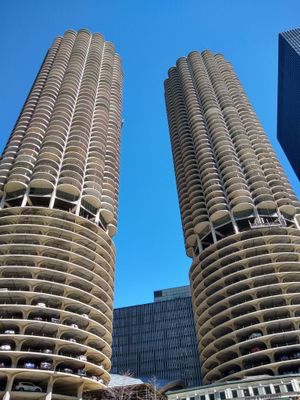
In front, Trump Tower and its 98 floors of steel and glass. Unsurprisingly it dominates the skyline, but it manages to do so without the brashness of its president owner.
Turning right, the Wrigley building. Here you can remove the sunnies as Trump’s dazzling glass is replaced by pretty terra cotta and the former headquarters of the world’s most famous chewing gum company.
Continuing around, and not being distracted by the tall Tribune Tower behind, the Apple building lies on the banks of the river. With a flat Mac-style roof resting on nothing but glass, the store is a subtle reminder that downtown buildings don’t have to be big. Juxtaposed with the historic Tower, it’s also a reminder that Chicago’s skyline has been evolving since the Great Fire of 1871.
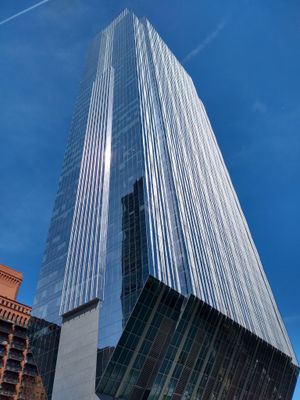
As our volunteer guide explains, the fire was devastating. It killed 300 people, destroyed more than 17,000 buildings and left a third of the city’s population homeless. But in the ashes of the fire lay the opportunity for reinvigoration. And with cranes, high-viz and rising scaffolding towers still on every block, it’s clear the construction has continued ever since.
Rising highest out of skyscraper city is Willis Tower, for 25 years the tallest building in the world. Here the reward for surviving the ear-popping elevator ride is a spectacular panorama which, by stretching out to the low-rise suburbs, also serves as a timely reminder that not all of Chicago is glass, steel and wealth.
Nowadays, however, just as many visitors are here for ‘The Ledge’. Up on the 103rd floor four glass panels, each made up of three half-inch thick panes, poke four feet out and provide an unbroken and clear view all 1,353 feet down to the ground. Dizzying.

Year of theatre
But it’s not all about the buildings. With a musical history to rival any city, one of the best galleries in North America and more than 200 theatres, the Windy City is a true arts heavyweight. Given 2019 is the ‘Year of Chicago Theatre’, let’s take a whistle-stop stage tour.
First, Second City.
If you don’t know it, you’ll know its alumni. Think Bill Murray, Mike Myers, Amy Poehler, Steve Carrell, Tina Fey, John Belushi.… The improvisational comedy theatre practically has a conveyor belt delivering A-grade talent to Saturday Night Live and Hollywood. In the current revue show (Algorithm Nation or The Static Quo) the jokes are mixed but the talent is clear and the laughs are loud.
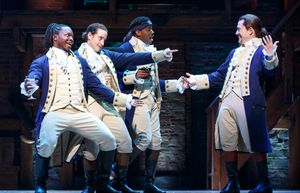
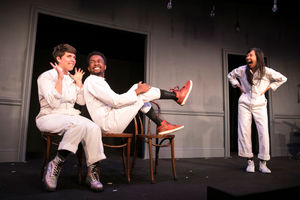
Next, Hamilton.
Given it’s probably the hottest musical in the world right now, there’s little value in me waxing lyrical apart from to say it lives up to some very high expectations. But why watch it in Chicago? Well, tickets here don’t require six months of planning and a remortgaged house.
Third: Djembe!
The least known but biggest success of this three-stage tour is an interactive musical tour across the globe built around the power of the djembe drum. Djembes are under every seat and playing is compulsory. And, by the look of the entire audience, so is sporting a broad grin throughout. Excellent.
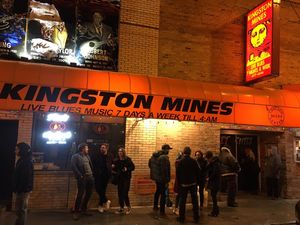
Perhaps the best entertainment of all, however, comes back among friends at Kingston Mines. With great service, great company and two stages of bluesy boogie brilliance, you really have to question the sanity of anybody who fails to have a good time.
What to choose?
As with any great city, however, there are two key challenges: (A) Staying sensible enough at night to capitalise on the riches by day and (B) Deciding what to pack into those limited days.
And in Chicago (B) is a particular challenge.
Sacred sport site or mesmerising museum?
Delicate international dining or local deep dish pizza?
Park, river, or outrageously big lake?
To fit it all in you'd need a month and some serious scheduling skills.
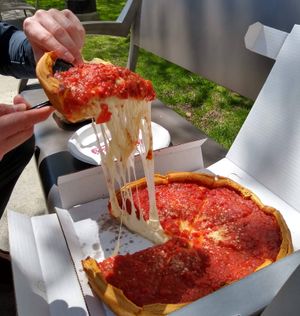
Occupying top spot in said riches is the Art Institute. If you’re in town for a few days and have no time for the back catalogue, this gallery equivalent of a greatest hits compilation is a must. Its walls are lined with Seurat, Monet, Warhol, Van Gogh, Pollock, Chagall and more. And with its airy accessible manner situated on the edge of 25-acre Millenium Park, it feels far less stuffier than its European equivalents.
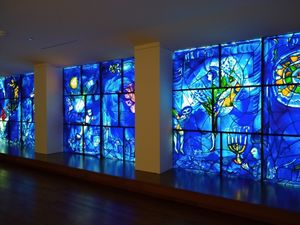
Given the opportunity, however, there is one place not to miss - and you won’t find this treasure trove on TripAdvisor.
Instead you need to head to the Chicago Cultural Centre, navigate an industrial lift, make your way past a mini-museum of a corridor and walk into the office of Tim Samuleson, the city’s cultural historian.
Inside, you'll be taken back in time as you open Al Capone's doorknob, get arrested in Eliot Ness’s handcuffs and sing and dance to a ‘20s pianola.
If you’re lucky, you’ll get an appointment and if you’re really lucky, you’ll get invited for drinks.
If not, there’s always Kingston Mines.
Fact box
I was a guest of Choose Chicago, the Chicago tourist board.
Fly from Manchester or Birmingham via Dublin with the benefit of US Preclearance and avoiding immigration queues in the US. Prices with Aer Lingus start from around £400 return.
We stayed at The Drake Hotel and The Palmer House, both historic Hilton Hotels with 565 and 1,641 rooms respectively. Doubles start from $163 per night.
The Chicago CityPASS costs $108 and includes entry into five of the city’s top attractions, including the Art Institute, over a nine-day period. See www.citypass.com/chicago.
Tickets for Hamilton, Second City and Djembe! are all available online with prices starting at around $30.
The Architecture River Cruise runs at least every hour, lasts 90 minutes and costs $45. See www.architecture.org
See live blues at Kingston Mines seven nights a week, with a weeknight cover charge of $12. For upcoming acts see kingstonmines.com


